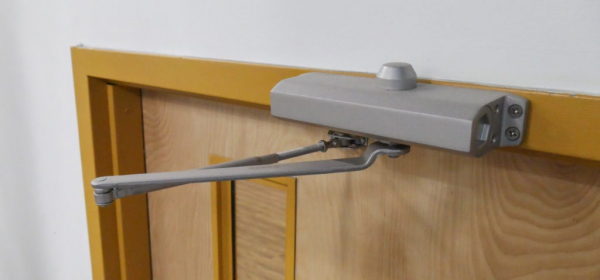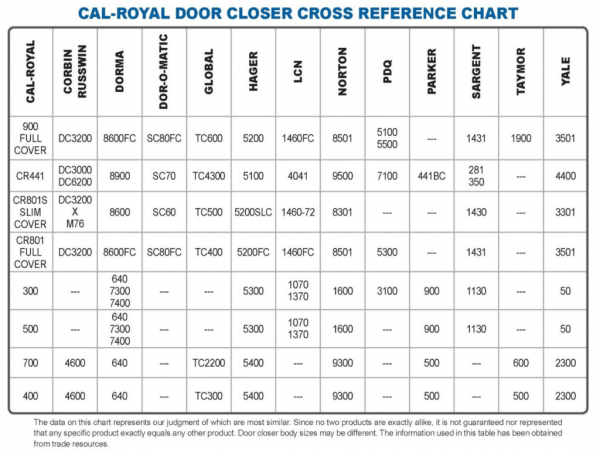Door closers are devices found and often required on doors throughout a wide variety of commercial facilities. Understanding how they work, the different types that are available today, which models are best for your doors, how to measure doors and door closers, and the answers to other questions regarding door closers, will all be covered in this door closer guide. This guide is recommended for anyone who maintains or purchases door closers. There are a wide variety of door closers available, which makes the buying process confusing. Our hope is that with guidance from this article, you’ll know what information to have on hand when you call one of our expert sales reps, so that they have everything they need to explain all of your options, and find the right door closer for your situation.

General Door Closer Know-How
What exactly is a door closer? A door closer is a mechanical device mounted on a door or door frame that closes the door in a controlled way. Why are door closers needed? Because doors can cause accessibility issues, especially for people with disabilities, and seniors (or anyone) with limited strength. If a door closes too quickly for people to get through, or too much force is needed to open a door, a door closer is the solution. Door closers provide a controlled way to close the door, and specify the force required to open it. A door closer will prevent the door from slamming shut after it is opened either by a person, or automatically.
Door closers are required in a variety of situations. One place you should always find door closers are on fire rated doors. All fire rated doors must close and latch automatically every time they are opened. Door closers are the best way to ensure this always happens.

The Three Main Types of Door Closers
There are many different types of door closers, including overhead door closers, concealed door closers, surface-mounted door closers, and floor-spring door closers. In this article, we cover the most popular type of door closer: overhead door closers. There are three different mounting methods of overhead door closers:
- Regular Arm: Also known as Standard Arm. This option is the most power-efficient option available, although it’s also the least attractive. The closer is a pull-side application that is located on the exterior of the door. There are two arms that connect together in this mounting style, one piece attaches to the frame, and the other piece attaches to a piston on the door closer body. These two arm pieces either screw or slide together. When the door is closed, the arm projects out perpendicular to the door.
- Parallel Arm: Parallel door closers are aptly named for how the arms sit parallel against the face of the door when the door is closed. They are the nicest looking type of door closer because the arm does not protrude away from the door or frame. The arms attach to the door on the frame and on the spindle of the door closer body. These types of door closers are popular in schools and other commercial properties because the arm is tucked in and is less likely to be misused or vandalized. Although more attractive and less prone to vandalism, these closers are less powerful than regular arm or top hinge closers due to the arm geometry.
- Top Hinge: Also known as Top Jamb. Essentially, these door closers are regular arm closers turned upside down. Like regular arm closers, top hinge closers have arms that have perpendicular projection out from the door. The difference is that the door closer body is mounted to the face of the door frame, not the door. Top jamb doors are commonly used for storefront doors as well as aluminum or glass doors, because these doors have narrow top rails. Top hinge closers are nearly as power efficient as regular arm closers.

Many door closers are fully reversible door closers, meaning that they can be installed in one of the three mounting methods listed above due to the star-shaped design of the arm mounting hole.

Additional Door Closer Parts:
- Spacer bracket: Available to fill space if needed. Unnecessary if mounting regular or top hinge, but used when needed for parallel arm mounted door closers.
- Sex bolts: Sex bolts are male and female screws and bolts used to mount the closer body to the door. A sex bolt is a heavy-duty through bolt that sandwiches the door to make sure the mounting screws don’t pull through the skins of the door. Four sex bolts are necessary to mount a closer. If not sex bolts, then through bolts with washers will also work, but through bolts will not be as aesthetically pleasing. We do not recommend using wood screws, especially in composite wood doors because they will eventually pull through.
Requirements for Doors with Door Closers
Common ADA Door Access Requirements
Listed below are some general ADA requirements for common door situations. It is recommended that you review federal, state, and even local building codes for additional help in choosing the right door closer for your needs. The Builders Hardware Manufacturers Association (BHMA) and American National Standards Institute (ANSI) provide extensive standards for door closers as well.
● The swing speed of the door must not be faster than five seconds. The swing distance is measured from when the door is in the open position or 90 degrees from the closed position, to 12 degrees from the latch. The speed should be fast enough to latch the door, but not slam it.
● Interior doors should not require more than 5 pounds of force to open. This applies to the initial force needed to overcome the weight of the door.
● The maximum force required for exterior doors is not specified by the ADA, however, they recommend the most minimal force possible. According to the ADA National Network, typical maximum opening force for exterior doors ranges from 8.5 to 10 lbs. ADA Guidelines state that heavy doors could prevent people with disabilities from gaining entrance to certain buildings, and thus prevent them from having access to goods and services. State and local government codes may also have specific accessibility requirements for exterior doors.
How to Choose the Right Door Closer
Door Closer Grades
Matching the door to the right type of door closer is critical. Essentially, heavier doors and doors with high traffic volumes require stronger, more durable door closers. These door closers are Grade 1. Lighter doors with medium to light duty traffic can use Grade 2 door closers. Very light doors that rarely get used can use Grade 3 door closers, which offer more closing control than using spring hinges. Listed below are the various grades and the traffic they are rated for. Door closer grades are determined by testing them in a neutral air pressure laboratory at 60-85 degrees fahrenheit.
● Grade 1: 2,000,000 cycles at 60% efficiency
● Grade 2: 1,000,000 cycles at 60% efficiency
● Grade 3: 500,000 cycles at 50% efficiency
Door Closer Sizes
Door closers come in sizes 1 to 6. Size 1 door closers are used on small, lightweight doors. Size 6 door closers are used for wide, heavy, tall doors like large solid wood doors. Many door closers are now resizable, meaning that they can be sized in the field during installation for a specified size range, like sizes 1-6. The most widely used setting is size 3, and most standard adjustable closers will be set to size 3 when shipped. Choosing an adjustable size door closer is a great option if you are unsure about the size you should choose.
Cal Royal 900 Door Closer Size Chart
Below is a size chart from door closer manufacturer Cal Royal for one of their most popular adjustable models, the 900 series door closer. It gives you a general sense of what size door closer is needed for a variety of different door sizes.

Factors to Consider When Choosing the Right Door Closer
● Size and weight of the door
● Location of the door
● Opening and closing frequency
● Mounting location
● Affordability
● Backswing requirements
● Traffic Volume
The easiest way to determine what door closer is needed for your door is by telling us the manufacturer and model number of the door closer you are replacing, when possible. Then, we can either match it, or look at other manufacturers to find a comparable model. Sometimes the models from other manufacturers have a lower price point, but with similar or superior quality.
If you do not know what door closer model you had before, or if you wish to switch to a new closer that is not similar to the model you have, then the following information will help us find the best closer for your needs:
- The size and weight of your door
- What is the application (school, office, industrial)
- Where the door is located
- What grade door closer you require – heavy, medium, or light duty traffic?
- What size door closer you require
- How much space at the top of the door is available for the closer
- What material your door is made of
- Is the door fire rated
- What requirements your door with door closer must meet

Cal Royal Door Closers
Cal Royal is a door closer manufacturer that has been creating door closers since the 1980’s. Equiparts has been working with Cal Royal for many years. Our sales reps and customer care teams receive ongoing training from Cal Royal that includes the latest information on door closer requirements and codes, updates to existing door closer models, and education on new products. This training helps us to better serve our customers.

Our latest door closer training was in September of 2019. We had the honor of hosting Mary Barrett and Thomas Barrett for a lunch-n-learn. At the presentation, Mary shared the differences between various models of door closers, explaining when one should be used over another, and tons of other facts and figures to help keep the Equiparts team current on all things commercial door closer related.
Cal Royal Door Closer Comparison Chart

We carry replacement commercial door closers for the following door closer manufacturers:
● Corbin Russwin
● Dorma
● DOR-O-MATIC
● Global
● Hager
● LCN
● Norton
● PDQ
● Parker
● Sargent
● Taymor
● Yale
● Cal Royal
Equiparts carries replacements for virtually all commercial door closer manufacturers. For more information, or to order the door closers needed to keep your doors up to code and closing smoothly, give one of our trained door closer sales representatives a call!
Toll-free: 800-442-6622
Pittsburgh: 412-781-9100
Phone hours: Monday-Friday 7:30AM – 5PM EST
Door Closer FAQs
Q: How do I measure door opening force and closing speed?
A: A door pressure gauge, also known as a door force gauge, is the best way to measure door-opening force. To use, first unlatch the door and press the gauge against the door. Push the door until it is open all the way. Then read the pressure gauge to learn what force is needed to open the door.
Q: Why is my door closer leaking?
A: Generally because the seals have worn out, or someone has adjusted one of the valves too far out.
Q: How do I fix a leaking door closer?
A: In some instances, we can repair the door closer leak by replacing the seal. In most cases, the door closer simply needs to be replaced.
Q: What is the difference between a full cover and a slim cover door closer?
A slim cover door closer is where the bottom piston spindle sticks out of the bottom of the cover, unlike a full cover that completely encapsulates the entire door closer body.
Q: What is a cushion stop or cushion arm?
A: A cushion arm is an arm that contains a stop. The cushion is actually a stop that absorbs some of the energy as the door is opened to the maximum opening point.
Q: What type of door closer can be used to hold open a fire rated door?
A: A fire rated door can use a track door closer, which gets wired into the fire alarm system. This track contains a solenoid that releases the hold open mechanism in the track so when the fire alarm goes off, it closes the door automatically. Call to order.


